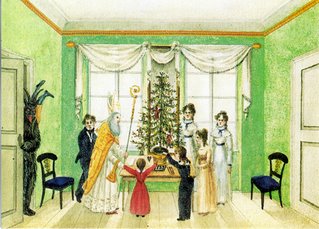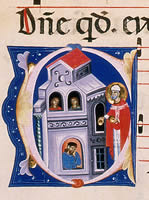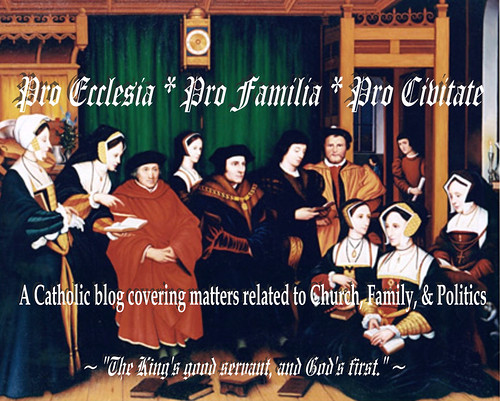Feast of St. Nicholas - 6 December

From the Medieval Saints Yahoo Group:
St. Nicholas, Bishop of Myra, Lycia (modern Turkey)
Also known as Klaus; Mikulas; Nicholas of Bari; Nicholas the
wonderworker; Nicolaas; Nicolas; Niklas; Santa Claus
Died c.346 at Myra; relics believed to be at Bari, Italy
Commemorated December 6
Patronage: against imprisonment, against robberies, against robbers, apothecaries, bakers, Bari, Italy, barrel makers, boatmen, boot blacks, boys, brewers, brides, captives, children, coopers, dock workers, druggists, Duronia, Italy, fishermen, Greece, grooms, judges, lawsuits lost unjustly, longshoremen, Lorraine, maidens, mariners, merchants, murderers, newlyweds, old maids, parish clerks, paupers, pawnbrokers, perfumeries, perfumers, pharmacists, pilgrims, poor people, Portsmouth England, prisoners, Russia, sailors, scholars, schoolchildren, shoe shiners, Sicily, spinsters, students, thieves, travellers, unmarried girls, watermen
In art, his attributes include 3 balls; anchor; ship; bishop with 3 children in a tub at his feet; 3 golden balls on a book; bishop calming a storm; 3 bags of gold; bishop holding 3 balls; bishop holding 3 bags of gold; bishop with 3 children
Nicholas of Myra (Bari) B (RM)
http://www.saintpatrickdc.org/ss/1206.htm#nich
Died c. 350. St. Nicholas was probably born to wealthy parents at Patara in Lycia, a province of Asia Minor. He was chosen bishop of the then rundown diocese of the capital of Myra, which he ruled with great care and faith. There he became known for his holiness, zeal, and miracles. To these meager facts legend, however, has supplied colorful details. His first 'biography' was written in the 9th century; a more popular one was written by Simon Metaphrastes in the 10th century.
Greek histories hold that he suffered imprisonment and made a famous confession during the persecution of Diocletian. He was present at the Council of Nicaea, where he condemned Arianism--one story holds that he actually slapped the heretic Arius. He died at Myra in Lycia. However, there is no historical support for either his confession nor his attendance at the council.
By the time of Justinian (6th century), there was a basilica built in his honor at Constantinople. From the 9th century in the East and the 11th century in the West, he has been one of the most popular saints of Christendom and the subject of many legends. These hold that he was a wealthy young man who decided to devote his money to charitable activities and his life to converting sinners.
The legends tell of how St. Nicholas, still sticky from the womb, rose up out of his first bath to fold his hands and raise his eyes to heaven in order to cleanse his heart before his body. He is also said to have taught his wet nurse about mortification by refusing her breast more than once on each Wednesday and Friday--a precocious exercise of asceticism!
Nicholas could have found communion with God in a monastic life, but to walk within the confines of a cloister would be insufficient for the saint's devotion. He wanted to be able to follow the footsteps of Jesus in the Palestine, which he did. On his voyages across the sea, he calmed the waves (which is why he is patron of sailors and travellers).
A citizen of Patara lost his fortune, and because he could not raise dowries for his three daughters, he was going to give them over to prostitution. After hearing this, Nicholas took a bag of gold and threw it through the window of the man's house at night. The eldest girl was married with it as her dowry. He performed the same action for each of the other girls. The three purses, portrayed in art with the saint, were mistakenly thought to be the heads of children, and thus originated the story that three children, murdered by an innkeeper and pickled in a tub of brine, were resuscitated by Nicholas. The three purses are also thought to be the origin of the pawnbrokers' symbol of three gold balls.
Another legend holds that he appeared to sailors caught in storms off the coast of Lycia and led them safely into port. Churches built under his dedication are often placed so that they can be seen off the coast as landmarks.
Yet another legend has it that he appeared to Constantine in a dream and thereby caused him to save three unjustly condemned imperial officers from death. Possibly another version says that the governor of Myra took a bribe to condemn to death three innocent men. The executioner was about to kill them when the bishop of the city, Nicholas, appeared and prevented the execution. Turning to the governor, the saint upbraided him till he confessed his sin and begged to be forgiven.
When Myra fell into the hands of the Saracens, Italian cities seized the chance to acquire the relics of Nicholas. The relics were stolen by Italian merchants and came to Bari in southern Italy in 1087. A new church was built to shelter them, and Pope Urban II was present at their enshrining. The already popular saint became even more highly regarded thereafter. The shrine became one of the great pilgrimage centers of medieval Europe. Many miracles were reputed to have been worked through his intercession.
The popular cultural representation of "St. Nick" is based on a combination of Low Countries' custom of giving children presents on his feast day as their patron, and the Dutch Protestants of New Amsterdam (now New York) linking this to Nordic folklore of a magician who punished naughty children and rewarded exemplary ones with presents. (It should be noted that the figure of Santa Claus is really non-Christian and is based on the Germanic god Thor, who was associated with winter and the Yule log and rode on a chariot drawn by goats named Cracker and Gnasher.)
Throughout Europe in the middle ages, St. Nicholas's feast day was the occasion for electing a Boy Bishop, who reigned until the feast of the Holy Innocents on December 28. Even in this century the custom survives in Montserrat in Catalonia, Spain (Attwater, Benedictines, Bentley, Delaney, Encyclopedia, White).
St. Nicholas's emblem in art is three balls. Sometimes he is portrayed (1) as a young man throwing three golden balls into the window of three poor girls; (2) raising three children from a pickle tub; (3) rescuing survivors from a shipwreck; (4) reviving a man unjustly hanged (not to be confused with Nicholas of Tolentino, who is never a bishop); or (5) as a new-born babe praising God. Venerated at Bari, Monserrat, and Russia (Roeder).
Patron of children (Santa Claus, Sint Klaus), bankers, captives (because of the rescue), pawnbrokers (three balls), and sailors (for miraculously saving doomed mariners off the coast of Lycia) (Roeder), brides, unmarried women (because he provided dowries), perfumers (from his shrine at Bari there was said to originate a fragrant 'myrrh'), of travellers, pilgrims, and safe journeys (because he reputedly travelled to the Holy Land and Egypt), maritime pilots (White), boatmen, fishermen, sailors, dock workers, stevedores, brewers, coopers, bootblacks, the unjustly judged, and poets (Encyclopedia). Russia, Greece, Sicily, Lorraine, Moscow, Freibourg, and Apulia all fall under his patronage, too (White).
---------------
More on St. Nicholas:
http://www.catholic-forum.com/saints/golden133.htm
http://www.newadvent.org/cathen/11063b.htm
http://www.stnicholascenter.org/Brix?pageID=38
http://www.stthomasirondequoit.com/SaintsAlive/id680.htm

UPDATE
See also Tom Fitzpatrick's post on St. Nicholas at Recta Ratio.
Labels: Culture, Saints and Martyrs, Traditional Feast Days



1 Comments:
Happy Feast Day to you and Yours.
Post a Comment
<< Home